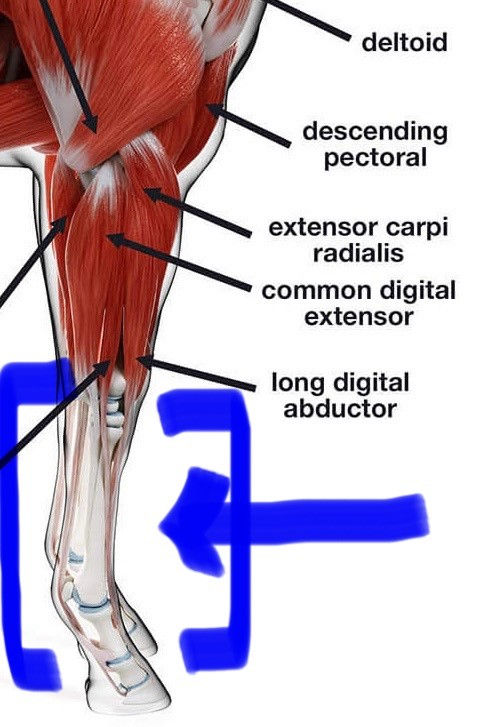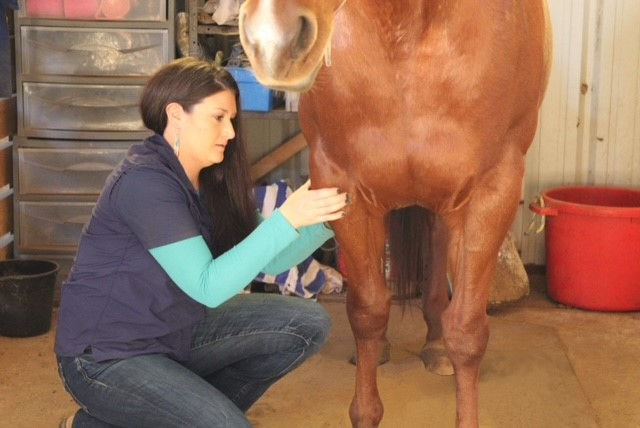Common Tension In the Equine Forelimbs
- Heather U

- Jan 14, 2024
- 3 min read
Updated: Jan 15, 2024
Is your horse presenting signs of tension in his foreleg extensor muscles?
Decreased ability to extend distal forelimb
Swelling, stiffness near the triceps/biceps or descending pectorals
Knuckling over onto dorsal aspect of distal limb
Lameness or stiff gait
Reluctance at the walk, trot, or canter
While this is often an area of our horses that seems to go unnoticed, it is commonly the reason for certain symptoms and behaviors. In many of the horses that I work on, I find tightness in these groups of muscles (see image for reference).
This tension is often released during a bodywork session, and through changes in routine discussed with the horse owner, but what happens to cause such tension in the horse's forelimbs?

No muscle = lack of blood flow.
Well, to explain this, I will first point out that the horse has zero muscle below the carpus (aka knee) and hock. In this region of the lower limbs, because the horse has only tendons and ligaments to support the his massive body, his forelimbs are not able to absorb the same level of concussion that the muscles can absorb. See above image area highlighted in blue.
The tendons and ligaments don't have the same blood supply that muscles have. Tendons and ligaments are far denser, and more fibrous and they don't contract and expand the same way that muscles do. For these reasons, tendon and ligament injuries tend to take much longer than muscle injuries to heal.
Concussion leads to tension.
With all of the activities that our horses do while under saddle comes concussion on the horse's forelimbs which as I mentioned above, cannot be easily absorbed by the horse's forelimbs. Further horses carry approximately 60% of their bodyweight on their forelimbs, making the groups of muscles pictured prime areas to hold tension as a result. Examples of concussion include:
Standing for prolonged periods of time on hard surfaces like concrete
Trotting on roads
Trailer travel
Riding on hard surfaces
Jumping
Riding patterns repetitively
Sports that place more weight onto the forehand
These kinds of high impact activities can easily cause the muscles in the equine foreleg to become tense, and therefore the horse experiences pain, inflammatory response, and a lack of proper extension in his movements. A horse's reduced range of motion (inflammation within tissues) will often cause him discomfort.
Another thing that will occur when the foreleg muscles become tight, is the body will naturally enlist other muscle groups to compensate, leading to more unfortunate issues.
But how can you help your horses with this tension after your bodywork practitioner has come and gone?
Use a rubber curry comb and try cross-fiber grooming in the areas of your horses' forelimbs and throughout his body a few times a week. To do this you'll gently use the curry comb in a back and forth or circular motion along the muscles and bone.
I cannot emphasize this enough: warm up and cool down each time you ride and stretch your horses before work! Just as humans benefit from stretching prior to workouts, horses do too! A relaxed warm-up in the arena or paddock whether under saddle or on the lunge line followed by a post ride cool down can make all the difference.
Ensure he is moving around in between appointments; horses shouldn't be left standing in small spaces for long periods of time such as when they are stalled for too long. Mild exercise on softer surfaces encourages blood flow, and joint lubrication. (This helps greatly in keeping your horse from becoming stiff).
Remember, most horses are carrying tension in their foreleg muscles, so we can be proactive as horse owners by readily addressing this tension before it starts/worsens.




Comments